
In the early days, agriculture was the main backbone of the economy. Before, the inventions of the steam engine, more or less every country on this planet were an agrarian economy. However, many phenomenon happened in between; the invention of steam engines which led the foundation of the Industrial Revolution, the two biggest World Wars and the rise of capitalism which led to the market economy. This phenomenon all led to the idea that apart from agriculture there are other sectors of the economy which are more attractive especially to the young population.
In the developing as well as developed economies this phenomenon is slowly gaining momentum. According to the World Bank, the worldwide population of people who are employed in agriculture dropped from around 44% in 1991 to 26% in 2022. These shows a trend which the world is witnessing at the moment. In the European economies, which enjoy one of the largest government subsidies for the farmers, this trend is also increasing. For example, in Switzerland, the phenomenon of agricultural land abandonment, where farmers leave agriculture and go for jobs elsewhere, has been happening for the past 150 years. Emerging economies like India is also a facing the brunt of this shifts. According to a report by Pratap S. Birthal, 40% of farmers dislike farming as a profession because of low profits, high risk and lack of social status, yet they continue with it due to lack of opportunities in other sectors.
The reasons why people are leaving farming are almost similar in all developing as well developed countries. Pratap Birthal have highlighted that lack of profitability, high risk and lack of social status in farming are few of the most important reasons behind this leave which is more or less similar to the situation in Switzerland which is a developed economy. But farmers in Switzerland enjoys a bigger privilege in terms of government support. According to OECD website, the total support given to the farmers of EU in the year 2022 was $101,196 million. But despite of this fact, why most of the farmers are not willing to continue farming?
Mario Gellrich states that the major reasons behind people leaving farming in Switzerland are large income differences between farm and non-farm income, the inability to develop modern land use. In India, it is a different story. The Indian government provides generous subsidies, exemption from income tax and crop insurance. They are guaranteed prices for 23 crops and debts are waived when they are unable to pay off loans. However, Indian farmers are mostly small or marginal. 68% of them own less than one hectare of land. Only 6% of them actually receive guaranteed price support for their crops and more than 90% of the farmers sell their produce in the market. According to a 2016 Economic Survey, the average income of a farming family in more than half of Indian’s states was a meagre IRs.20000which is not even 10%of the average per capita income of India!
In Nepal, the percentage of people doing agriculture is reducing although in a slower momentum. According to the recently published national census of Agriculture 2021-22, over the past ten years, the land used for temporary crops have reduced by 392,316 hectares (18.5%) while permanent crops have decreased by 23,093 hectares (13.7%). In this national report, the agriculture household accounted for 62% of the total households of the country. It was 71% in the last census 2011/12. This report also shows that the percentage of male headed holdings were 67.6% and female headed holdings were 32.4% in 2021/22 whereas it was 19% for female headed holdings and 81% for male headed holdings in 2011/12. Over the past decades, the percentage of female headed holdings have increased significantly. This skyrocketing female holdings indicate that the male population have either left farming or have migrated nationally or internationally in search of job opportunities.
This trend shows that despite of the government backing support to the farmers, the farmers are not willing to farm anymore. Most of this is related to the lower status that farmers receive while the status that non-farmers receive is relatively higher. This also directs us to the trend of migration which is one of the major causes for people leaving land and going elsewhere in search of opportunities. Scholars such as Professor Jeevan R. Sharma in his book “Crossing the Border to India: Youth,Migration, and Masculinities inNepal” have stated that migrants themselves are agents of change and they are no longer the victims or pawns of the system which they have no control over. Various other scholars have also stated that migration has been instilled in the socio cultural aspect of the society. Initially, in Nepal most of the people in the rural areas were envious of the “Lahure” culture. All of the people wanted to become “Lahure” and earn social prestige like them. This has been expanded in various aspects. Initially, it was limited to internal migration (within the country). Now, it has extended beyond the national boundaries.
I think, the people leaving agriculture and going elsewhere is an intricate web which has multiple aspects. It should not be analyzed from the singular perspective of economics only. For example, why the farmers of Switzerland are willing to leave agriculture despite of the fact that the government there provides immense support (financial and non financial) to the farmer? Why the issue of land abandonment is increasing even in developing countries where agricultural is a major contributor of the economy? This has a multiple aspect to discuss which is poorly considered by the policy makers. It not only has a monetary aspect. It also has a cultural aspect which should not be singled out.
Pratik Poudel is a PhD Candidate at Department of Development, Planning, Management and Innovation (DPMI) School of Environment and Resource Development (SERD), Asian Institute of Technology (AIT)Pathum, Thani, Thailand

Pratik Poudel
Poudel is a Research Associate, Nepal Water Conservation Foundation for Academic Research, Chundevi, Kathmandu
- Bridging Risk-Sensitive Land Use Planning and Farmland Abandonment: Policy Pathways for Disaster Risk Reduction and Resilience
- May 23, 2025
- Why Upstream And Downstream Linkage In The River System Can’t Be Ignored?
- Feb 19, 2021
- Is The Lingering Of the Budhigandaki Hydropower Project The Sign Of Indo -Chinese Confrontation?
- Dec 18, 2020
- How Can The Problems Of Koshi Region Be Addressed Through A Nexus Perspective?
- Nov 21, 2020
- Addressing Water Security In The South Asian Region Through Nexus Governance
- Sep 08, 2020















